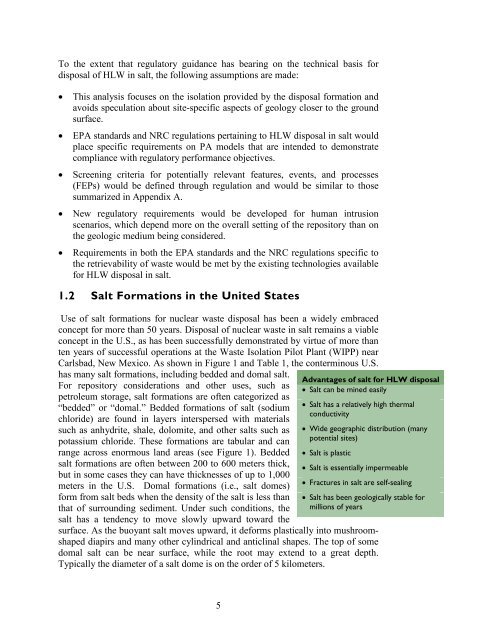Salt Disposal of Heat-Generating Nuclear Waste
Salt Disposal of Heat-Generating Nuclear Waste
Salt Disposal of Heat-Generating Nuclear Waste
Create successful ePaper yourself
Turn your PDF publications into a flip-book with our unique Google optimized e-Paper software.
To the extent that regulatory guidance has bearing on the technical basis for<br />
disposal <strong>of</strong> HLW in salt, the following assumptions are made:<br />
• This analysis focuses on the isolation provided by the disposal formation and<br />
avoids speculation about site-specific aspects <strong>of</strong> geology closer to the ground<br />
surface.<br />
• EPA standards and NRC regulations pertaining to HLW disposal in salt would<br />
place specific requirements on PA models that are intended to demonstrate<br />
compliance with regulatory performance objectives.<br />
• Screening criteria for potentially relevant features, events, and processes<br />
(FEPs) would be defined through regulation and would be similar to those<br />
summarized in Appendix A.<br />
• New regulatory requirements would be developed for human intrusion<br />
scenarios, which depend more on the overall setting <strong>of</strong> the repository than on<br />
the geologic medium being considered.<br />
• Requirements in both the EPA standards and the NRC regulations specific to<br />
the retrievability <strong>of</strong> waste would be met by the existing technologies available<br />
for HLW disposal in salt.<br />
1.2 <strong>Salt</strong> Formations in the United States<br />
Use <strong>of</strong> salt formations for nuclear waste disposal has been a widely embraced<br />
concept for more than 50 years. <strong>Disposal</strong> <strong>of</strong> nuclear waste in salt remains a viable<br />
concept in the U.S., as has been successfully demonstrated by virtue <strong>of</strong> more than<br />
ten years <strong>of</strong> successful operations at the <strong>Waste</strong> Isolation Pilot Plant (WIPP) near<br />
Carlsbad, New Mexico. As shown in Figure 1 and Table 1, the conterminous U.S.<br />
has many salt formations, including bedded and domal salt.<br />
For repository considerations and other uses, such as<br />
petroleum storage, salt formations are <strong>of</strong>ten categorized as<br />
“bedded” or “domal.” Bedded formations <strong>of</strong> salt (sodium<br />
chloride) are found in layers interspersed with materials<br />
such as anhydrite, shale, dolomite, and other salts such as<br />
potassium chloride. These formations are tabular and can<br />
range across enormous land areas (see Figure 1). Bedded<br />
salt formations are <strong>of</strong>ten between 200 to 600 meters thick,<br />
but in some cases they can have thicknesses <strong>of</strong> up to 1,000<br />
meters in the U.S. Domal formations (i.e., salt domes)<br />
form from salt beds when the density <strong>of</strong> the salt is less than<br />
that <strong>of</strong> surrounding sediment. Under such conditions, the<br />
salt has a tendency to move slowly upward toward the<br />
Advantages <strong>of</strong> salt for HLW disposal<br />
• <strong>Salt</strong> can be mined easily<br />
• <strong>Salt</strong> has a relatively high thermal<br />
conductivity<br />
• Wide geographic distribution (many<br />
potential sites)<br />
• <strong>Salt</strong> is plastic<br />
• <strong>Salt</strong> is essentially impermeable<br />
• Fractures in salt are self-sealing<br />
• <strong>Salt</strong> has been geologically stable for<br />
millions <strong>of</strong> years<br />
surface. As the buoyant salt moves upward, it deforms plastically into mushroomshaped<br />
diapirs and many other cylindrical and anticlinal shapes. The top <strong>of</strong> some<br />
domal salt can be near surface, while the root may extend to a great depth.<br />
Typically the diameter <strong>of</strong> a salt dome is on the order <strong>of</strong> 5 kilometers.<br />
5
















